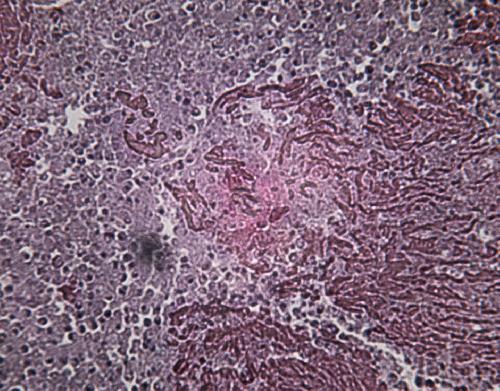New research finds that the most commonly used test for tuberculosis fails to accurately diagnose TB in up to 50 percent of pregnant women who are HIV+. The research published early online in the American Thoracic Society's American Journal of Respiratory and Critical Care Medicine is believed to be the first study to compare the accuracy of two TB tests - the Quantiferon Gold In Tube® blood test and the more commonly used TST or tuberculin skin test--in this population. The study "Quantitative IFN-?, IL-2 Response and Latent Tuberculosis Test Discordance in HIV-infected Pregnant Women" is also the first study to examine pregnancy's effect on the body's response to TB.
The researchers' aim in this study was two-fold: (1) to assess the accuracy of TB tests in diagnosing a highly contagious and world-wide public health scourge in patients who are doubly at risk and (2) to find a method to identify which women carrying latent TB infection are most likely to develop active TB. In latent TB the individual is infected but does not show any symptoms. Some individuals with latent TB go on to develop active TB--the form of the disease that causes symptoms in the carrier and transmission to others. While a healthy, functioning immune system can keep the infection in check, pregnancy and HIV infection, which compromise the immune system, increase the chances of developing active TB. Therefore, there is a critical need to improve diagnosis.
"The World Health Organization and many governments endorse the TST because it is a cheap and ubiquitous test," said lead study author Jyoti Mathad, MD, MSc, Instructor of Medicine in the Center for Global Health at Weill Cornell Medical College. "However, our over-reliance on this single test means that we are failing to detect and treat a potentially life-threatening infection in tens of millions of high-risk women."
 This is a TB infected lung. Credit: ATS
This is a TB infected lung. Credit: ATS
"We found that QGIT positivity was almost three times higher than the more widely used TST at every time point tested," noted the authors.
Dr. Mathad and her colleagues enrolled 252 women who were in their second or third trimester and receiving care at a public teaching hospital in India. The women received TB testing at enrollment during pregnancy or at delivery. An additional 39 women participated in a longitudinal study to assess how the TB tests were affected by changes in different stages of pregnancy. They were tested at delivery and three months postpartum. The researchers also collected blood samples to assess for levels of infection-fighting proteins.
"Our blood data suggests that pregnant women produce lower levels of the immune chemicals that many TB diagnostics look for. This finding has implications beyond diagnostics," said Dr. Mathad. "For example, not all pregnant women lose immune control of TB infection. But, currently we have no way of predicting which women are most likely to get sick from the disease. Our findings about these immune chemicals provide a starting point for developing a test that will tell us who in this already high-risk population is at greatest risk of disease and death and is in most need of treatment." She added that this insight about indicators of risk would also benefit other high-risk groups such as the elderly, young children and all people who are HIV positive.
In terms of the broader significance of their findings, the researchers would welcome a greater effort to include pregnant women in future medical studies. "...pregnant women have been excluded from all 40 trials of new TB drugs that are ongoing today," said Dr. Mathad. "Some of the caution is justified, but, oftentimes, it is simply the path of least resistance. This habit - and habit is all that it is in many cases- exacts a toll on women worldwide. Pregnant women often get stuck taking longer regimens of outdated drugs due to a lack of research."
About the American Journal of Respiratory and Critical Care Medicine (AJRCCM):The AJRCCM is a peer-reviewed journal published by the American Thoracic Society. The Journal takes pride in publishing the most innovative science and the highest quality reviews, practice guidelines and statements in pulmonary, critical care and sleep medicine. With an impact factor of 12.996, it is the highest ranked journal in pulmonology. Editor: Jadwiga Wedzicha, MD, professor of respiratory medicine at the National Heart and Lung Institute (Royal Brompton Campus), Imperial College London, UK.
About the American Thoracic Society:Founded in 1905, the American Thoracic Society is the world's leading medical association dedicated to advancing pulmonary, critical care and sleep medicine. The Society's 15,000 members prevent and fight respiratory disease around the globe through research, education, patient care and advocacy. The ATS publishes three journals, the American Journal of Respiratory and Critical Care Medicine, the American Journal of Respiratory Cell and Molecular Biology and the Annals of the American Thoracic Society.
source: American Thoracic Society